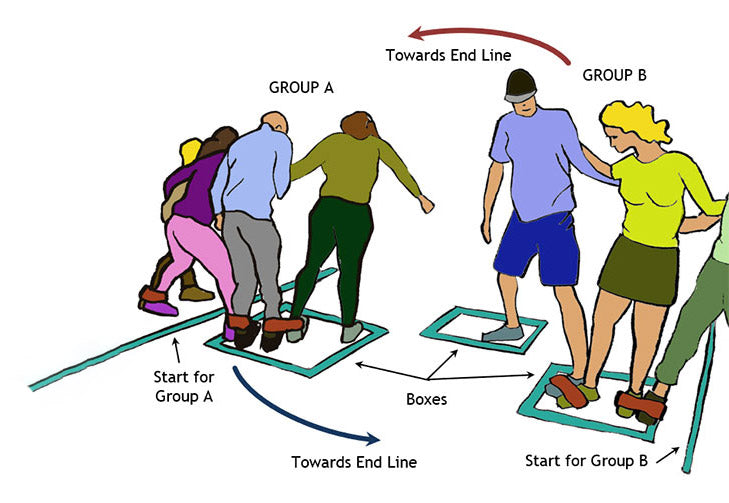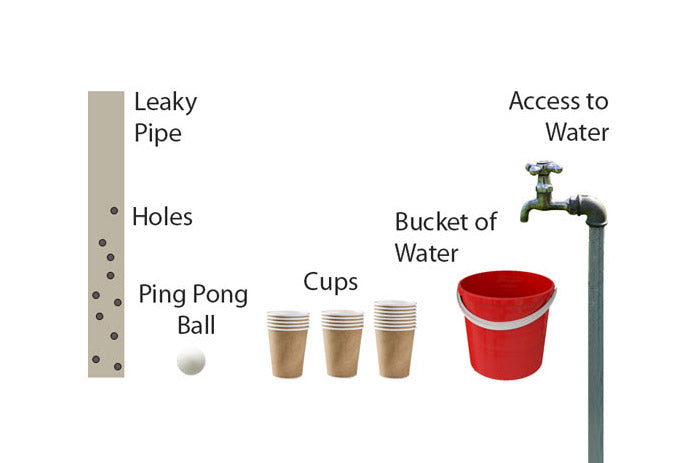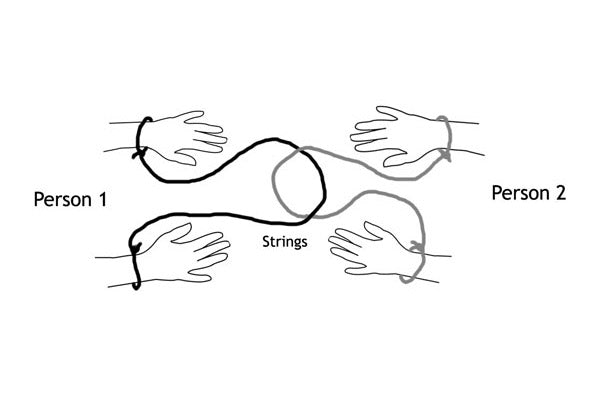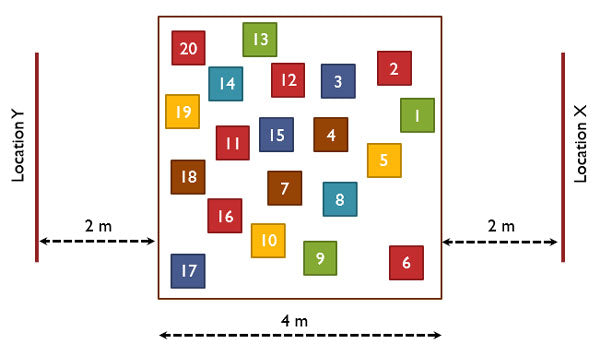Purpose
This is an entertaining team building activity where delegates get to practice working together towards a common objective while following certain rules. It is ideal for exploring leadership, planning, strategic thinking, communicating and creative thinking.
Objective
While physically attached to your neighbour, traverse an area from one location to another while adhering to the rules and responding to challenges.
What You Need
- Duct tape or strings. You will need these to attach ankles together. Use a variety that does not damage cloths or shoes.
- Masking tape.
- An area about 4 by 4 meters or larger.
Setup
- Create an area using the masking tape such as the image shown below. You will need a starting point, an end point and a series of boxes in between. The distance between the boxes should not be more than 30 cm. Equally, the boxes should not be closer than 30 cm to the start or end point.
- Divide the delegates to two groups and assign each group to one of the starting lines.
- Explain that the objective for each group is to start behind one line and end up on the other side of the other line while adhering to the rules.
- You may set the exercise as cooperative or competitive. Competitively, the group that crosses first safely and successfully wins. Cooperatively, both groups work together to complete the task swiftly, each aiming to cross to the other side while also helping the other group to succeed.
- Make up a story to make the exercise more interesting. For example, the group is shipwrecked and must traverse a hazardous area while attached to each other and move away from a danger zone to a safe location.
- Provide the tapes to delegates.
- Ask the two groups to form a line near their corresponding starting area.
- Ask each group to tape their feet to each other as shown in the image while forming a line.
- Consider the following safety checks:
- Delegates should not tape skin as skin can be damaged. Make them aware that certain cloth can also be damaged.
- Anyone who has a back, ankle or knee issue should not participate.
- Anyone who has difficulty with balance should not participate.
- Delegates should move slowly as to make sure the exercise is conducted safely.
- While crossing, they should consider these rules:
- Delegates need to go through the square boxes and cannot step outside, otherwise their feet will melt!
- They cannot take the tapes off.
- They must remain in line while traversing from the start point to the endpoint for each group while their ankles are attached.
- The entire group should end up on the other side of the end line to finish the task.
- Time their performance to provide a bit of pressure.
- Start the exercise on your mark.
- Observe and provide feedback as necessary to make sure rules are adhered to or if anything is not clear.
- Following with a debriefing.
Timing
Explaining the Exercise: 10 minutes
Activity: 20 minutes
Group Feedback: 10 minutes
Discussion
How did you manage the task? Did you assign a leader? What do you think of the quality of communication among team members? How did you address developing issues? How did each group do? Was one group much better than the other? Why? What would you do differently next time to improve the performance?
Variations
- You can optionally make the exercise more difficult using the following variations:
- Rather than having two groups, just use one group and ask them to cross from one side to another.
- Turn the lights off briefly for 5 seconds periodically and see how they handle it.
- Play loud music periodically for 30 seconds that make verbal conversation difficult and see how they manage.
- Change the configuration or increase the number of boxes in between to make the task more difficult.
Soft Skills Training Materials
Get downloadable training materials
Online Train the Trainer Course:
Core Skills
Learn How to Become the Best Trainer in Your Field
All Tags
Training Resources for You

Course Design Strategy
Available as paperback and ebook

Free Training Resources
Download a free comprehensive training package including training guidelines, soft skills training activities, assessment forms and useful training resources that you can use to enhance your courses.

Our Comprehensive Guide to Body Language

Train the Trainer Resources
Get Insights - Read Guides and Books - Attend Courses
Training Materials
Get downloadable training materials on: Management Training, Personal Development, Interpersonal Development, Human Resources, and Sales & Marketing















Leave a comment
All comments are moderated before being published.
This site is protected by reCAPTCHA and the Google Privacy Policy and Terms of Service apply.